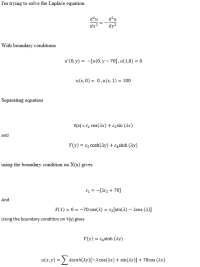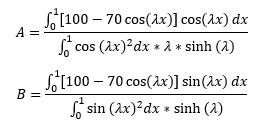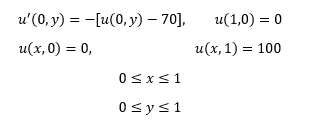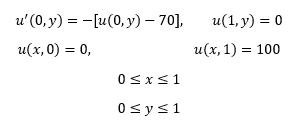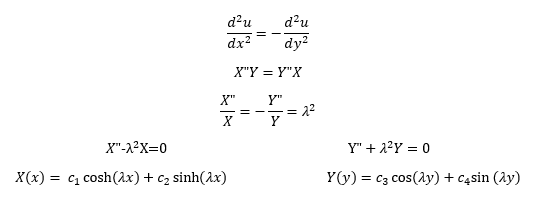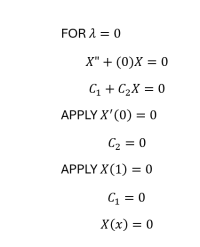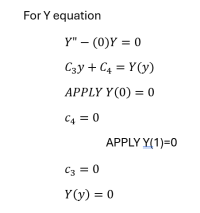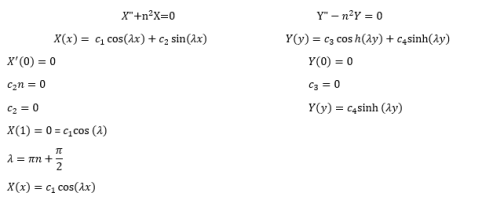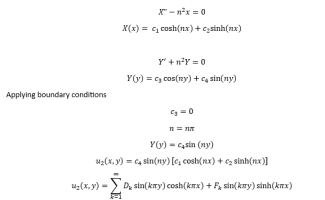When we force the boundary conditions to be zero, we don't apply the boundary conditions to the hyperbolic solution.
So, we have these two solutions:
[imath]X(x) = c_1\cos nx[/imath], where [imath]\displaystyle n = \frac{(2k - 1)\pi}{2}[/imath], [imath]\displaystyle k = 1,2,3,4,........[/imath]
And
[imath]Y(y) = c_3\cosh ny + c_4 \sinh ny[/imath]
Our first solution is:
[imath]\displaystyle u_1(x,y) = X(x)Y(y) = c_1\cos nx(c_3\cosh ny + c_4 \sinh ny)[/imath]
Or
We can write it with superposition principle as:
[imath]\displaystyle u_1(x,y) = \sum_{k=1}^{\infty} \left(A_k \cosh \frac{(2k - 1)\pi}{2}y + B_k \sinh \frac{(2k - 1)\pi}{2}y\right)\cos \frac{(2k - 1)\pi}{2}x[/imath]
Now our goal is to find the constants [imath]A_k[/imath] and [imath]B_k[/imath]. We will rewrite our boundary conditions in such a way that we can define some functions.
[imath]u'(0,y) = F(y) = (0, -[u(0,y) - 70])[/imath]
[imath]u(1,y) = G(y) = (0, 0)[/imath]
[imath]u(x,0) = F(x) = (0, 0)[/imath]
[imath]u(x,1) = G(x) = (100, 0)[/imath]
This means:
[imath]F(y) = -[u(0,y) - 70][/imath]
[imath]G(y) = 0[/imath]
[imath]F(x) = 0[/imath]
[imath]G(x) = 100[/imath]
Now the constants [imath]A_k[/imath] and [imath]B_k[/imath] are defined like this:
[imath]\displaystyle A_k = \int_{0}^{1} F(x) \cos\frac{(2k-1)\pi}{2}x \ dx[/imath]
[imath]\displaystyle B_k = \frac{1}{\sinh \frac{(2k-1)\pi}{2}}\left(\int_{0}^{1}G(x)\cos\frac{(2k-1)\pi}{2}x \ dx - A_k\cosh \frac{(2k-1)\pi}{2}\right)[/imath]
After that, you have to solve for [imath]\lambda = -n^2 < 0.[/imath]
[imath]X''- n^2 X = 0[/imath]
[imath]Y'' + n^2 Y = 0[/imath]
[imath]Y(0) = 0[/imath]
[imath]Y(1) = 0[/imath]
Solve them and apply the given boundary conditions.
